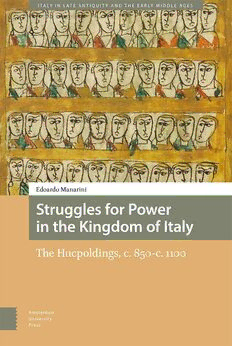
Struggles for Power in the Kingdom of Italy: The Hucpoldings, c. 850-c. 1100 PDF
Preview Struggles for Power in the Kingdom of Italy: The Hucpoldings, c. 850-c. 1100
ITALY IN LATE ANTIQUITY AND THE EARLY MIDDLE AGES M a n a r i n i S t r u g g l e s f o r P o w Edoardo Manarini e r i n t Struggles for Power h e K i in the Kingdom of Italy n g d o m o f The Hucpoldings, c. 850-c. 1100 I t a l y Struggles for Power in the Kingdom of Italy Italy in Late Antiquity and the Early Middle Ages The enduring culture of Italy has sustained and transformed human life and experience throughout its long history. Undoubtedly the transformations of the peninsula in the Late Antique and Early Medieval periods are redolent of change and challenge for societies and individuals. This series aims to bridge the gap between Anglophone and Italian scholarship, and more broadly to make works of Italian scholars better known throughout Europe. The series aims to present the best high quality research on the Italian peninsula and the Central Mediterranean in Late Antiquity and the Early Middle Ages. It covers the period from the end of the Western Roman Empire to the Ottonians in Italy encompassing Ostrogothic, Lombard and Carolingian Italy. An important aim of this series is to encourage cross-disciplinarity in research associated not only with history, but also archaeology, art history, religious studies and all cognate disciplines. In publishing scholarship from the Anglophone world and from Italy and beyond the series will encourage and deepen knowledge of the central Mediterranean in this fascinating formative period. Series editors Dr Christopher Heath, Manchester Metropolitan University Dr Edoardo Manarini, Università di Torino Editorial Board Prof Ross Balzaretti, University of Nottingham Prof François Bougard, Institut de recherche et d’histoire des textes/Centre National de la Recherche Scientifique, Paris Dr Clemens Gantner, Austrian Academy of Sciences Prof Tiziana Lazzari, Università di Bologna Prof Edward Schoolman, University of Nevada, Reno Struggles for Power in the Kingdom of Italy The Hucpoldings, c.850–c.1100 Edoardo Manarini Amsterdam University Press Cover illustration: Legislatores gentis Alamannorum, Archivio Storico Diocesano di Modena- Nonantola, Biblioteca Capitolare, O.I.2, fol. 110v (digital copy purchased for publication purposes). Cover design: Coördesign, Leiden Lay-out: Crius Group, Hulshout isbn 978 94 6372 582 8 e-isbn 978 90 4855 058 6 doi 10.5117/9789463725828 nur 398 © E. Manarini / Amsterdam University Press B.V., Amsterdam 2022 All rights reserved. Without limiting the rights under copyright reserved above, no part of this book may be reproduced, stored in or introduced into a retrieval system, or transmitted, in any form or by any means (electronic, mechanical, photocopying, recording or otherwise) without the written permission of both the copyright owner and the author of the book. Every effort has been made to obtain permission to use all copyrighted illustrations reproduced in this book. Nonetheless, whosoever believes to have rights to this material is advised to contact the publisher. For Alda and Clavio, Emilia, Elena, and Laerte Table of Contents Prefatory Note 9 Acknowledgements 11 Maps and Tables 13 Abbreviations 15 Preface by Simon MacLean 19 Introduction 21 Part I Kinship and Political Relations 1. The Hucpoldings’ Involvement in the Political Struggles of the Kingdom of Italy (847–945) 45 Hucpold, Count Palatine of Louis II 48 Faction and Endeavour: Hubald I 57 The Aristocratic Career of Boniface dux et marchio between Rudolf II and Hugh of Arles 64 Bibliography 72 2. Family Patterns and Political Affirmation (945–1012) 83 The Duchy of Spoleto and Tuscany 87 Eastern Emilia and the Exarchate of Ravenna 95 The March of Tuscany 106 Bibliography 115 3. The Local Basis of Power in a Wide Political Network (1012–1116) 125 Hugh II and His Lineage in Bologna and Ferrara 130 The Ties that Bind: Boniface of Canossa and Kinship Networks across the Apennines 140 The Counts of Romena-Panico 148 Bibliography 152 Part II Properties and Patronage 4. The Exarchate 165 Land Possession and Relations in the Ninth Century 167 The Troubled Years, c.960–c.1000 174 Persistence in the comitatus Faentinus and the 1034 Pact 178 Bibliography 181 5. The March of Tuscany 185 The Family Group Estates in the Ninth Century 187 Marchisal Fisc and Monastic Foundations 192 Centres of Power, Patronage Networks 201 Bibliography 212 6. Ruling on the Border : Landed Possessions from the Po Valley to the Apennines in Bononia’s Diocese 217 Acquisitions, Exchanges, Organization of Lands in the Tenth Century 221 Landed Wealth and Hegemony 229 Lands, People and Castles (900–1100) 238 Estate Management: Between Territorial Consolidation and Dispersal 247 Bibliography 256 Part III Power, Relationships, Memory 7. Kinship, Self-awareness and Memory 267 Onomastic Choices 272 The lex Ribuaria profession 277 The Role of Monastic Foundations: Family Memory, Politics and Identity 284 Kinship Representations between Perceptions and Self-awareness 290 Evolution and Hierarchy of Kinship Cohesion 300 Bibliography 302 8. Features and Practices of Power: From Officials to Lords 311 Firsts Steps at Court: Offices and Responsibilities in the Kingdom of Italy 313 The Marchisal Achievement and the Gaining of Ecclesiastical Offices 319 Dinastizzazione of the Title of comes and the Development of Seigneurial Rule in a Border Region 327 Bibliography 331 9. Discontinuity between Public Powers and Private Seigneurial Rule 335 Bibliography 340 Genealogical Tables 343 Bibliography 353 Index 385 Prefatory Note Almost all personal names in this book are rendered into modern English from Latin, thus Boniface for Bonifacius or Adalbert for Adelbertus. In cases when names are not present in modern English, I chose a regularized Latin form, like Cuniza or Winizus. Ecclesiastical names of churches and religious institutions are rendered in Italian for the sake of clarity. When using Latin expressions or phrases in sentences a translation can be found in either the main text or in the relevant footnote.
